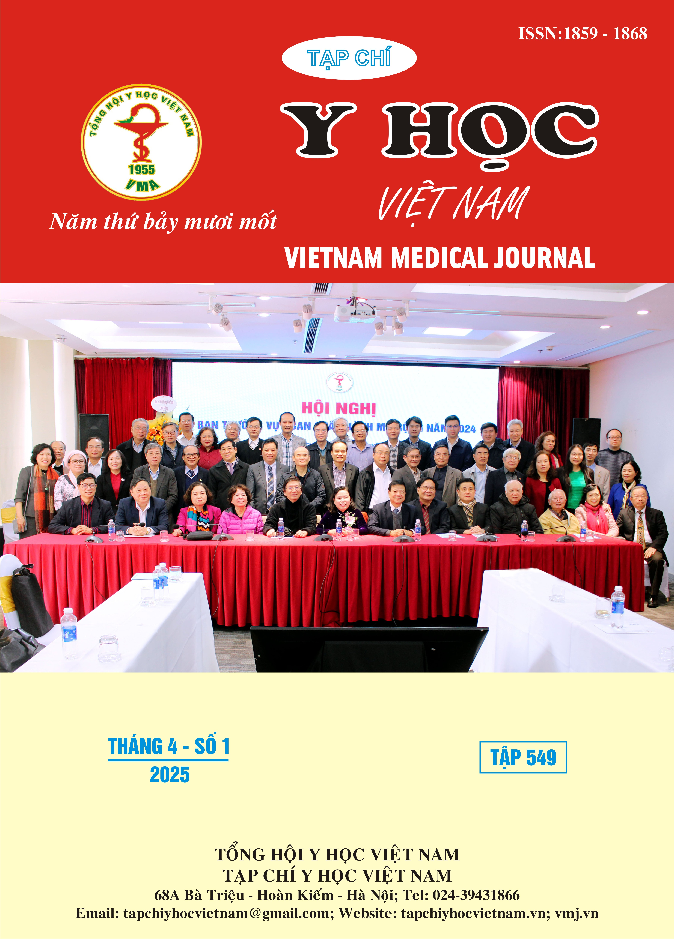EVALUATION OF THE TREATMENT OUTCOMES OF OCULAR HYPERTENSION DUE TO LENS DISLOCATION OR SUBLUXATION AFTER TRAUMA AT THE VIETNAM NATIONAL EYE HOSPITAL IN 2024-2025
Main Article Content
Abstract
Objective: To evaluate the treatment outcomes of increased intraocular pressure due to lens dislocation or subluxation following blunt ocular trauma. Subjects and Methods: A descriptive interventional study without a control group was conducted on 35 eyes diagnosed with increased intraocular pressure due to lens dislocation or subluxation after blunt ocular trauma. These patients were treated at the Ocular Trauma Department of the Vietnam National Eye Hospital from May 2024 to February 2025. Results: The male-to-female ratio was 3.37:1. The average age of the study patients was 51.3±14.6 years. Patients aged 16–60 years accounted for 68.6%, those over 60 years made up 25.7%, and those under 16 years comprised only 5.7%. The most common cause of trauma was occupational accidents (51.4%), followed by domestic accidents (31.4%). Most patients presented with very poor visual acuity at hospital admission: 74.3% had visual acuity worse than 20/200, and no patients had visual acuity better than 20/40. The mean intraocular pressure (IOP) at admission was 28.2±3.0 mmHg. The most common lens pathology was lens subluxation (68.6%), followed by lens dislocation into the vitreous cavity (22.9%) and into the anterior chamber (8.6%). Narrow or closed anterior chamber angles were present in 68.6% of cases. Associated injuries included sphincter muscle damage (77.1%), corneal edema or abrasion (51.4%), and vitreous prolapse into the anterior chamber (45.7%). After treatment, at both one and three months, most patients showed significant improvement in visual acuity and IOP. The mean visual acuity at admission was 1.58±0.55, improving to 0.81±0.47 at one month and 0.74±0.48 at three months. The mean IOP at admission was 28.2±3.01 mmHg, decreasing to 17.5±2.33 mmHg at one month and 17.4±1.98 mmHg at three months. The optic disc condition remained stable after treatment. Conclusion: Increased intraocular pressure due to lens dislocation or subluxation following blunt ocular trauma is a common complication that leads to severe visual impairment. Timely diagnosis and appropriate treatment play a crucial role in improving patient outcomes.
Article Details
Keywords
lens subluxation, increased intraocular pressure, blunt ocular trauma
References
2. L. Công Đức, “Đặc điểm lâm sàng và điều trị sa lệch thể thủy tinh do chấn thương đụng dập nhãn cầu”, Luận văn Thạc sĩ Y học, Trường Đại học Y Hà Nội, 2002.
3. K. M. Vũ, “Đặc điểm lâm sàng và kết quả điều trị ban đầu chấn thương đụng dập nhãn cầu tại Bệnh viện Mắt Trung ương từ 2003 đến 2007”, Đại học Y Hà Nội, 2008.
4. V. Huy Quang, “Nghiên cứu đặc điểm lâm sàng của tăng nhãn áp sớm sau chấn thương đụng dập nhãn cầu và kết quả điều trị”, Luận văn Thạc sĩ Y học, Trường Đại học Y Hà Nội, 2016.
5. C. Boudet, “Traumatologie du cristallin”, trong Soc.Fr, Ophtalmol, Masson, 1979, tr 224–276.
6. Việt Nga H., “Nghiên cứu về tăng nhãn áp sau sa lệch TTT do chấn thương đụng dập và phương pháp điều trị”, Luận văn Thạc sĩ Y học, Trường Đại học Y Hà Nội, 1999.
7. K. Iwasaki, R. Komori, S. Arimura, Y. Takamura, và M. Inatani, “Intraocular Pressure-Lowering Effect of Intraocular Lens Refixation in Patients with Elevated Intraocular Pressure Due to Intraocular Lens Subluxation”, Med. Kaunas Lith., vol 60, số p.h 9, tr 1440, tháng 9 2024, doi: 10.3390/medicina60091440.


